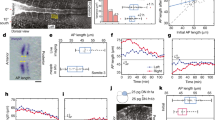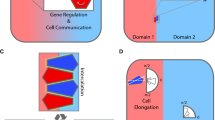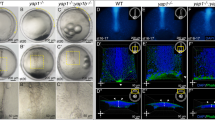Abstract
Actively regulated symmetry breaking, which is ubiquitous in biological cells, underlies phenomena such as directed cellular movement and morphological polarization. Here, we investigate how an organ-level polarity pattern emerges through symmetry breaking at the cellular level during the formation of a mechanosensory organ. Combining theory, genetic perturbations and in vivo imaging, we study the development and regeneration of the fluid-motion sensors in the zebrafish’s lateral line. We find that two interacting symmetry-breaking events—one mediated by biochemical signalling and the other by cellular mechanics—give rise to precise rotations of cell pairs, which produce a mirror-symmetric polarity pattern in the receptor organ.
This is a preview of subscription content, access via your institution
Access options
Access Nature and 54 other Nature Portfolio journals
Get Nature+, our best-value online-access subscription
$29.99 / 30 days
cancel any time
Subscribe to this journal
Receive 12 print issues and online access
$209.00 per year
only $17.42 per issue
Buy this article
- Purchase on Springer Link
- Instant access to full article PDF
Prices may be subject to local taxes which are calculated during checkout






Similar content being viewed by others
Data availability
Source data are available for this paper. All other data that support the plots within this paper and other findings of this study are available from the corresponding author upon reasonable request.
References
Lecuit, T. & Lenne, P. F. Cell surface mechanics and the control of cell shape, tissue patterns and morphogenesis. Nat. Rev. Mol. Cell Biol. 8, 633–644 (2007).
Eaton, S. & Jülicher, F. Cell flow and tissue polarity patterns. Curr. Opin. Genet. Dev. 21, 747–752 (2011).
Stooke-Vaughan, G. A. & Campàs, O. Physical control of tissue morphogenesis across scales. Curr. Opin. Genet. Dev. 51, 111–119 (2018).
Strutt, H. & Strutt, D. Asymmetric localisation of planar polarity proteins: mechanisms and consequences. Semin. Cell Dev. Biol. 20, 957–963 (2009).
Wallingford, J. B. Planar cell polarity and the developmental control of cell behavior in vertebrate embryos. Annu. Rev. Cell Dev. Biol. 28, 627–53 (2012).
Gross, P. et al. Guiding self-organized pattern formation in cell polarity establishment. Nat. Phys. 15, 293–300 (2019).
Shotwell, S. L., Jacobs, R. & Hudspeth, A. J. Directional sensitivity of individual vertebrate hair cells to controlled deflection of their hair bundles. Ann. N. Y. Acad. Sci. 374, 1–10 (1981).
Reichenbach, T. & Hudspeth, A. J. The physics of hearing: fluid mechanics and the active process of the inner ear. Rep. Prog. Phys. 77, 076601 (2014).
Deans, M. R. A balance of form and function: planar polarity and development of the vestibular maculae. Semin. Cell Dev. Biol. 24, 490–498 (2013).
Rouse, G. W. & Pickles, J. O. Paired development of hair cells in neuromasts of the teleost lateral line. Proc. R. Soc. B 246, 123–128 (1991).
Ghysen, A. & Dambly-Chaudière, C. Development of the zebrafish lateral line. Curr. Opin. Neurobiol. 14, 67–73 (2004).
López-Schier, H. & Hudspeth, A. J. A two-step mechanism underlies the planar polarization of regenerating sensory hair cells. Proc. Natl Acad. Sci. USA 103, 18615–18620 (2006).
Ezan, J. & Montcouquiol, M. Revisiting planar cell polarity in the inner ear. Semin. Cell Dev. Biol. 24, 499–506 (2013).
Jacobo, A., Dasgupta, A., Erzberger, A., Siletti, K. & Hudspeth, A. Notch-mediated determination of hair-bundle polarity in mechanosensory hair cells of the zebrafish lateral line. Curr. Biol. 29, 3579–3587 (2019).
Kozak, E. L. et al. Epithelial planar bipolarity emerges from Notch-mediated asymmetric inhibition of Emx2. Curr. Biol. 30, 1142–1151 (2020).
Corson, F., Couturier, L., Rouault, H., Mazouni, K. & Schweisguth, F. Self-organized Notch dynamics generate stereotyped sensory organ patterns in Drosophila. Science 356, eaai7407 (2017).
Jian, T., Kindt, K. & Wu, D. K. Transcription factor Emx2 controls stereociliary bundle orientation of sensory hair cells. eLife 6, e23661 (2017).
Ma, E. Y., Rubel, E. W. & Raible, D. W. Notch signaling regulates the extent of hair cell regeneration in the zebrafish lateral line. J. Neurosci. 28, 2261–2273 (2008).
Viader-Llargués, O., Lupperger, V., Pola-Morell, L., Marr, C. & López-Schier, H. Live cell-lineage tracing and machine learning reveal patterns of organ regeneration. eLife 7, e30823 (2018).
Pinto-Teixeira, F. et al. Inexhaustible hair-cell regeneration in young and aged zebrafish. Biol. Open 4, 903–909 (2015).
Kozlovskaja-Gumbriene, A. et al. Proliferation-independent regulation of organ size by Fgf/Notch signaling. eLife 6, e21049 (2017).
Heisenberg, C. P. & Bellaïche, Y. Forces in tissue morphogenesis and patterning. Cell 153, 948–962 (2013).
Maître, J. L. & Heisenberg, C. P. Three functions of cadherins in cell adhesion. Curr. Biol. 23, 626–633 (2013).
Maître, J.-L. et al. Adhesion functions in cell sorting by mechanically coupling the cortices of adhering cells. Science 338, 253–256 (2012).
Maître, J.-L. et al. Asymmetric division of contractile domains couples cell positioning and fate specification. Nature 536, 344–348 (2016).
Togashi, H. et al. Nectins establish a checkerboard-like cellular pattern in the auditory epithelium. Science 333, 1144–1147 (2011).
Fukuda, T. et al. Aberrant cochlear hair cell attachments caused by nectin-3 deficiency result in hair bundle abnormalities. Development 141, 399–409 (2014).
De Gennes, P.-G., Brochard-Wyart, F. & Quéré, D. Capillarity and Wetting Phenomena (Springer Science & Business Media, 2004).
Dow, E., Siletti, K. & Hudspeth, A. J. Cellular projections from sensory hair cells form polarity-specific scaffolds during synaptogenesis. Genes Dev. 29, 1087–1094 (2015).
Dow, E., Jacobo, A., Hossain, S., Siletti, K. & Hudspeth, A. J. Connectomics of the zebrafish’s lateral-line neuromast reveals wiring and miswiring in a simple microcircuit. eLife 7, e33988 (2018).
De Gennes, P. G. Wetting: statics and dynamics. Rev. Mod. Phys. 57, 827–863 (1985).
Jülicher, F., Kruse, K., Prost, J. & Joanny, J.-F. Active behavior of the cytoskeleton. Phys. Rep. 449, 3–28 (2007).
Ruprecht, V. et al. Cortical contractility triggers a stochastic switch to fast amoeboid cell motility. Cell 160, 673–685 (2015).
Liu, Y.-J. et al. Confinement and low adhesion induce fast amoeboid migration of slow mesenchymal. Cell 160, 659–672 (2015).
Bergert, M., Chandradoss, S. D., Desai, R. A. & Paluch, E. Cell mechanics control rapid transitions between blebs and lamellipodia during migration. Proc. Natl Acad. Sci. USA 109, 14434–14439 (2012).
Wibowo, I., Pinto-Teixeira, F., Satou, C., Higashijima, S.-i & López-Schier, H. Compartmentalized Notch signaling sustains epithelial mirror symmetry. Development 138, 1143–1152 (2011).
Mirkovic, I., Pylawka, S. & Hudspeth, A. J. Rearrangements between differentiating hair cells coordinate planar polarity and the establishment of mirror symmetry in lateral-line neuromasts. Biol. Open 1, 498–505 (2012).
Acedo, J. N. et al. PCP and Wnt pathway components act in parallel during zebrafish mechanosensory hair cell orientation. Nat. Commun. 10, 3993 (2019).
Brochard, F. Motions of droplets on solid surfaces induced by chemical or thermal gradients. Langmuir 5, 432–438 (1989).
Hawkins, R. J. et al. Spontaneous contractility-mediated cortical flow generates cell migration in three-dimensional environments. Biophys. J. 101, 1041–1045 (2011).
Kindt, K. S., Finch, G. & Nicolson, T. Kinocilia mediate mechanosensitivity in developing zebrafish hair cells. Dev. Cell 23, 329–341 (2012).
Scheer, N. & Campos-Ortega, J. A. Use of the Gal4-UAS technique for targeted gene expression in the zebrafish. Mech. Dev. 80, 153–158 (1999).
Haas, P. & Gilmour, D. Chemokine signaling mediates self-organizing tissue migration in the zebrafish lateral line. Dev. Cell 10, 673–680 (2006).
Gray, M., Moens, C. B., Amacher, S. L., Eisen, J. S. & Beattie, C. E. Zebrafish deadly seven functions in neurogenesis. Dev. Biol. 237, 306–323 (2001).
Jessen, J. R. et al. Zebrafish trilobite identifies new roles for strabismus in gastrulation and neuronal movements. Nat. Cell Biol. 4, 610–615 (2002).
Kimmel, C. B., Ballard, W. W., Kimmel, S. R., Ullmann, B. & Schilling, T. F. Stages of embryonic development of the zebrafish. Dev. Dyn. 203, 253–310 (1995).
Itoh, M. et al. Mind bomb is a ubiquitin ligase that is essential for efficient activation of Notch signaling by Delta. Dev. Cell 4, 67–82 (2003).
Weigert, M. et al. Content-aware image restoration: pushing the limits of fluorescence microscopy. Nat. Methods 15, 1090–1097 (2018).
Thévenaz, P., Ruttimann, U. E. & Unser, M. A pyramid approach to sub-pixel registration based on intensity mailing address. IEEE Trans. Image Process. 7, 27–41 (1998).
Marquez-Neila, P., Baumela, L. & Alvarez, L. A morphological approach to curvature-based evolution of curves and surfaces. IEEE Trans. Pattern Anal. Mach. Intell. 36, 2–17 (2013).
Acknowledgements
We thank A. Kaczynska for expert fish husbandry and A. Mietke, E. Siggia and the members of our research group for critical reading and comments on the manuscript. A.E. was supported by a Feodor Lynen Fellowship from the Alexander von Humboldt Foundation and A.J. by an F.M. Kirby Postdoctoral Fellowship from Rockefeller University. A.D. is a Postdoctoral Associate and A.J.H. an Investigator of Howard Hughes Medical Institute.
Author information
Authors and Affiliations
Contributions
A.E. and A.J. designed the research with contributions from A.D. and A.J.H. A.J. performed the experiments with contributions from A.D. A.E. developed the theory. A.E. and A.J. analysed the data. A.E. wrote the paper with contributions from A.J., A.D. and A.J.H.
Corresponding authors
Ethics declarations
Competing interests
The authors declare no competing interests.
Additional information
Publisher’s note Springer Nature remains neutral with regard to jurisdictional claims in published maps and institutional affiliations.
Supplementary information
Supplementary Information
Supplementary Figs. 1–9, Videos 1–4, note and references.
Supplementary Video 1
Sensory hair cells in a lateral line neuromast. In a confocal recording enhanced by content-aware image restoration (CARE), a scan from the apex to the base of a neuromast in a four-day-old Tg(myo6b:actb1-EGFP) zebrafish larva shows sensory hair cells labeled with β-actin–GFP. The orientation of each hair bundle is revealed by the location of the kinocilium, which appears as a dark spot on the actin-enriched apical surface of each hair cell.
Supplementary Video 2
Deep-learning-assisted, long-term imaging of hair-cell maturation. A maximum-intensity projection of a time-lapse recording shows a developing neuromast in a Tg(myo6b:actb1-EGFP) zebrafish larva. We used content-aware image restoration (CARE; right) to improve the signal-to-noise ratio in images taken at low laser power and short exposure times (left). Minimizing photo-induced damage to the sample allowed us to image cell pairs throughout their maturation at high spatiotemporal resolution. Note the appearance of a new pair of hair cells in the lower left, followed by a second pair in the upper region. Each pair of daughter cells is initially rounded, with a flat contact surface between the cells. During a subsequent phase of protrusive activity the cells separate from one another. Finally, distinct apical surfaces with oppositely polarized hair bundles appear. In this and Supplementary Video 3 and 4, the time signal is in hours and minutes.
Supplementary Video 3
Hair-cell maturation in a Notch mutant larva. A CARE-processed maximum-intensity projection of a time-lapse recording depicts a developing neuromast in a Tg(myo6b:actb1-EGFP) animal lacking functional Notch1a receptors (Notch1ab638/b638 mutant). The sensory hair-cell pairs form uniformly oriented actin protrusions during maturation and develop uniformly oriented hair bundles. Note the young pair of hair cells at the lower edge of the neuromast, both of which develop hair bundles oriented toward the animal’s posterior. A second pair of nascent hair cells appears after four hours at the neuromast’s upper margin.
Supplementary Video 4
Dipole transition of a pair of nascent hair cells. A CARE-enhanced time-lapse recording of a developing neuromast in a Tg(myo6b:actb1-EGFP) zebrafish larva is focussed at the level of hair cell-nuclei. The arrowhead in the first image denotes the location at which a progenitor cell appears and undergoes a division, giving rise to a pair of nascent hair cells. The two daughter cells maintain a flattened contact surface and undergo a rearrangement in which they switch positions along the PCP axis between 6:50 and 8:50. A second division near the upper edge of the neuromast yields a pair of cells that do not exchange places.
Rights and permissions
About this article
Cite this article
Erzberger, A., Jacobo, A., Dasgupta, A. et al. Mechanochemical symmetry breaking during morphogenesis of lateral-line sensory organs. Nat. Phys. 16, 949–957 (2020). https://doi.org/10.1038/s41567-020-0894-9
Received:
Accepted:
Published:
Issue Date:
DOI: https://doi.org/10.1038/s41567-020-0894-9



